around 600 Spaniards over 3000 Year 18 October 1540 | 200 2500-3000? | |
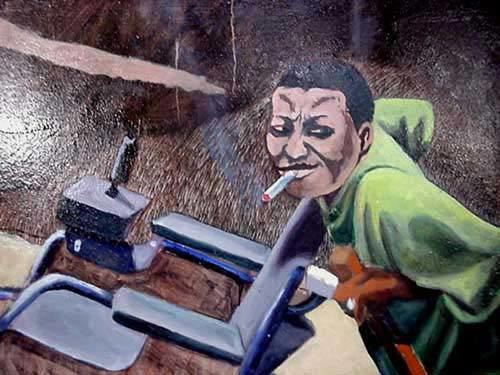 | ||
Mabila
The town of Mabila (or Mavila, Mavilla, Mauvilla) was a small fortress town known to Chief Tuskaloosa in 1540, in a region of present-day central Alabama. The exact location has been debated for centuries, but southwest of present-day Selma, Alabama, is one possibility. Mabila was a Trojan-horse, fake village concealing over 2500 native warriors, planning to attack the expedition of Spanish explorer Hernando de Soto in 1540.
Contents
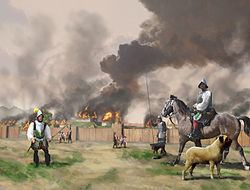
When Hernando de Soto had first met Tuskaloosa at his home village, and asked him for supplies, Tuskaloosa advised them to travel to another of his towns, known as Mabila, where supplies would be waiting. A native messenger was sent ahead to Mabila, but when Tuskaloosa and the first group of Spaniards arrived, Tuskaloosa simply asked them to leave. When a fight broke out between one soldier and a native, many hidden warriors emerged from houses and began shooting arrows. The Spaniards fled, leaving their possessions inside the fortress. The full conflict that resulted is called the Battle of Mabila.
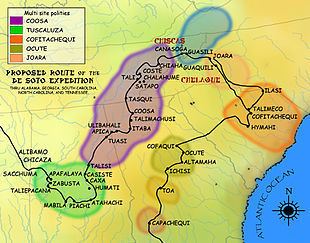
The fortress town
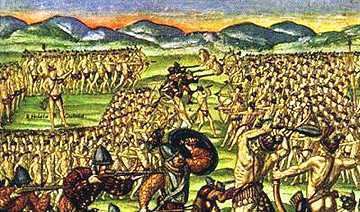
The walled compound of Mabila, one of many that the Spaniards encountered in their travels, was enclosed in a thick stuccoed wall, 16.5-ft (5-m) high, made from wide tree trunks tied with cross-beams and covered with mud/straw stucco, to appear as a solid wall. The fortress was defended by shooting arrows or throwing stones.
The town of Mabila was described by Garcilaso de la Vega as:
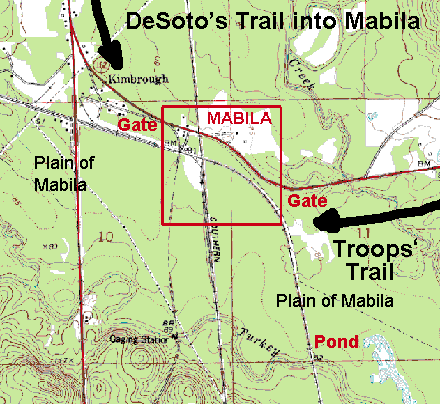
The Battle of Mabila
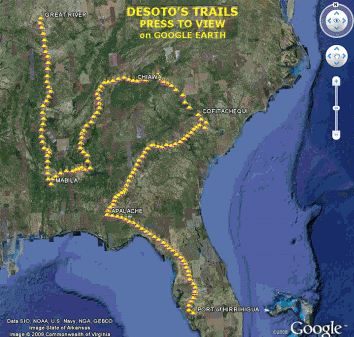
The greatest losses suffered by the Spaniards occurred during the battle at Mabila. De Soto had taken the powerful Chief Tuskaloosa, from his own town, to another town where the chief had promised to provide supplies.
On October 18, 1540, de Soto and the expedition arrived at Mabila, a heavily fortified village situated on a plain. It had a wooden palisade encircling it, with bastions every so often for archers to shoot their longbows. Upon arriving at Mabila, the Spaniards knew something was amiss. The population of the town was almost exclusively male- young warriors and men of status. There were several women, but no children. The Spaniards also noticed the palisade had been recently strengthened, and that all trees, bushes, and even weeds, had been cleared from outside the settlement for the length of a crossbow shot. Outside the palisade, in the field an older warrior had been seen haranguing younger warriors, and leading them in mock skirmishes and military exercises.
When the Spaniards reached the town of Mabila, ruled by one of Tuskaloosa's vassals, the Chief asked de Soto to allow him to remain there. When de Soto refused, Tuskaloosa warned him to leave the town, then withdrew to another room, and refused to talk further. A lesser chief was asked to intercede, but he would not. One of the Spaniards, according to Elvas, "seized him by the cloak of marten-skins that he had on, drew it off over his head, and left it in his hands; whereupon, the Indians all beginning to rise, he gave him a stroke with a cutlass, that laid open his back, when they, with loud yells, came out of the houses, discharging their bows."
The Spaniards barely escaped from the well-fortified town. The Indians closed the gates and "beating their drums, they raised flags, with great shouting." De Soto determined to attack the town, and in the battle that followed, Elvas records: "The Indians fought with so great spirit that they, many times, drove our people back out of the town. The struggle lasted so long that many Christians, weary and very thirsty, went to drink at a pond near by, tinged with the blood of the killed, and returned to the combat."
De Soto had his men set fire to the town, then by Elvas's account,
"breaking in upon the Indians and beating them down, they fled out of the place, the cavalry and infantry driving them back through the gates, where losing the hope of escape, they fought valiantly; and the Christians getting among them with cutlasses, they found themselves met on all sides by their strokes, when many, dashing headlong into the flaming houses, were smothered, and, heaped one upon another, burned to death."They who perished there were in all two thousand five hundred, a few more or less: of the Christians there fell two hundred... Of the living, one hundred and fifty (150) Christians had received seven hundred wounds..."Elvas noted later that four hundred hogs died in the conflagration.
The exact count of the dead is not known, but Spanish accounts at the time put the number of Indian dead at between 2,500 and 3,000. This range would make the battle one of the bloodiest in recorded North American history.
